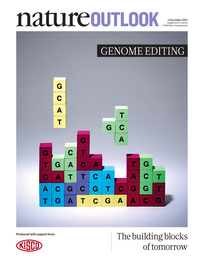 The term ‘genetic engineering’ has been around since the early 1970s, along with the idea that, by altering DNA, scientists can cure genetic disease or create superhumans. Reality, however, was much less exciting. It is only in the past few years that researchers have developed the tools that allow them to engineer the genome with the precision and ease originally envisioned — to be able to edit any DNA base anywhere in any genome. A CRISPR–Cas9 plasmid, the most recent of the widely used genome-editing tools, now costs US$65 or less. It can be ordered online, arrives in the post and requires little specialist training to use.
The term ‘genetic engineering’ has been around since the early 1970s, along with the idea that, by altering DNA, scientists can cure genetic disease or create superhumans. Reality, however, was much less exciting. It is only in the past few years that researchers have developed the tools that allow them to engineer the genome with the precision and ease originally envisioned — to be able to edit any DNA base anywhere in any genome. A CRISPR–Cas9 plasmid, the most recent of the widely used genome-editing tools, now costs US$65 or less. It can be ordered online, arrives in the post and requires little specialist training to use.
It is this availability and simplicity that has allowed genome editing to become common practice. Agricultural scientists and infectious disease experts are doing it, as are synthetic biologists. Epigeneticists have modified DNA-editing tools to manipulate their objects of study. Biotechnology companies are springing up, aiming to develop treatments based on genome editing. But some diseases are more amenable than others. One of the most advanced therapies is one that shuts HIV out of immune cells.
With so much activity, a thorough and inclusive discussion of the implications of this technology is vital.
Genome editing
by Anna Petherick
nature
cover art by Kyle Bean
http://www.nature.com/nature/journal/v528/n7580_supp/full/528S1a.html
With so much activity, a thorough and inclusive discussion of the implications of this technology is vital. Which is why the foremost scientific societies of three countries — the United States, United Kingdom and China — have come together this December to sponsor an international summit on the topic of editing the human germ line. Now is the time for the most respected scientists in the field to lay out the risks and benefits of genome editing to society, as Jennifer Doudna and George Church do in this Outlook.
We are pleased to acknowledge the financial support of KISCO Ltd. in association with EditForce Inc., in producing this Outlook. As always, Nature retains sole responsibility for all editorial content.
Genome editing
Anna Petherick
Nature 528, S1 (3 December 2015)
Three technologies that changed genetics
Amy Maxmen
Nature 528, S2–S3 (3 December 2015)
Research: Biology’s big hit
Zoë Corbyn
Nature 528, S4–S5 (3 December 2015)
Perspective: Embryo editing needs scrutiny
Jennifer Doudna
Nature 528, S6 (3 December 2015)
Perspective: Encourage the innovators
George Church
Nature 528, S7 (3 December 2015)
Disease: Closing the door on HIV
Michael Eisenstein
Nature 528, S8–S9 (3 December 2015)
Medicine: Expanding possibilities
Virginia Gewin
Nature 528, S10–S11 (3 December 2015)
Epigenetics: The genome unwrapped
Heidi Ledford
Nature 528, S12–S13 (3 December 2015)
Q&A: Cocktail maker
Tim Lu
Will Tauxe
Nature 528, S14 (3 December 2015)
Agriculture: A new breed of edits
Claire Ainsworth
Nature 528, S15–S16 (3 December 2015)
Genome editing: 4 big questions
Will Tauxe
Nature 528, S17 (3 December 2015)